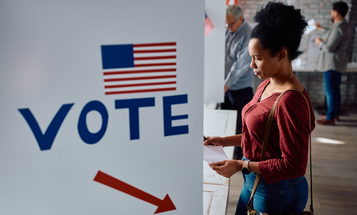
How to Create the Best Automatic Voter Registration System
Automatic Voter Registration (AVR)—meaning voter registration that occurs without a proactive effort by individual citizens—has caught fire following Oregon’s enactment of the first model last year with state legislatures in over half the country carry bills currently.
As best practices for AVR continue to develop, review of these bills reveals important distinctions that require deeper understanding. The critical question is: What policy designs are needed to ensure the most expansive, inclusive and secure means of access for voters?
Here are three major factors that stakeholders must address:
1. “Automatic” Voter Registration by Name, But Not by Function
A truly and fully automatic voter registration system occurs when information already provided to government is used to verify and register eligible voters, without making individuals self‑register or affirm their eligibility. Instead, individuals have the opportunity to decline registration after the eligibility process is complete.
Oregon’s “New Motor Voter” system operates in this fashion. Eligible unregistered voters found through the state’s DMV databases are notified by mail that they will be added to the voter rolls unless they decline by returning a postcard to the state’s election authorities. This model is arguably more inclusive; Oregon added over 10,000 new voters through its first seven weeks, while only 7% of people notified through mail opted out.
By contrast, many state bills offer voter modernization—upgrades to elections systems to allow electronic transfer of voter eligibility information—but stop short of being truly automatic. Before being added to the voter rolls, individuals must affirm their eligibility and/or formally answer whether or not they would like to be registered—even though government agencies can perform both tasks themselves. These are automated voter registration systems. While automated processes are necessary to adopt as building blocks to full AVR, they shouldn’t be conflated with an actual AVR system.
Regardless of the system adopted, all but six states must comply with voter registration requirements mandated by the 1993 National Voter Registration Act (NVRA). Either system can be implemented without compromising NVRA compliance mandates.
2. Public Agencies as AVR Source Agencies
Strong AVR systems must connect elections systems with the electronic systems of other governmental and public agencies—called “source agencies”—to seamlessly interact and share accurate voter data. Information provided by these agencies is vital to confirming voter eligibility before electronic transfer of any individual into an elections database.
The majority of current AVR bills include motor vehicles offices as the sole source agency. This is problematic because it ensures the perpetuation of current voter registration gaps. For example, African Americans and Latinos possess driver’s licenses or other DMV‑issued identifications in much lower proportions versus their white counterparts. Some state bills reflect lawmakers’ concerns about agencies’ lack of technical capacities required to electronically transfer information and thus prioritize technological upgrades and automated voter registration processes.
Inclusive and universal AVR must include a broad range of source agencies. Public assistance agencies (including Health Benefit Exchanges created by Obamacare) and disability offices—agencies and offices that mandate voter registration services through the NVRA, public universities and Department of Corrections are among a number of agencies that should be included. Less conventional state-specific databases that already contain AVR‑relevant information should also be considered. Alaska’s AVR ballot initiative, for example, features the state’s database for oil revenue dividends as the primary source agency.
Many state bills reflect concerns about many public agencies’ lack of technical capacities required to electronically transfer information and thus prioritize making the proper upgrades. These improvements should serve as building blocks for full AVR rather than as a final step.
3. Protections for Inadvertent Registrants
Administrative errors within AVR systems could result in the accidental registration of ineligible voters. Non-citizens particularly face dire consequences. Under current law in which individuals must make a proactive effort to register to vote, a non‑citizen who registers to vote can be deported with no chance of ever returning to the United States.
As a result, it's crucial that AVR statutes contain legal protections for ineligible voters who are inadvertently registered. This requires at least three things:
- States must have complete confidence in the information within the source databases included;
- States must hold sole responsibility for confirming voter eligibility; and
- Statutes must contain specific legislative language, known as “Safe Harbor” language, that states that ineligible individuals who get inadvertently registered have not made improper claims of citizenship or voter eligibility.
Under these provisions, in the event of an inadvertent registration, the ineligible voter has made no statements and/or signed no documents that assert a claim of citizenship—if the individual inadvertently becomes registered, it was as a result of action by the state, not the individual. This shifts the legal responsibility of registration from the individual to the state, drastically reducing one of the biggest concerns to implementing the most inclusive AVR system possible.
Because of AVR’s tremendous potential to transform how voting operates, now is the time to set precedents that most expansively and safely bring new people into the process. We have a golden opportunity to increase the size and quality of our electorate. Policymakers and advocates should take full advantage of this moment and get it right; our democracy needs it.



